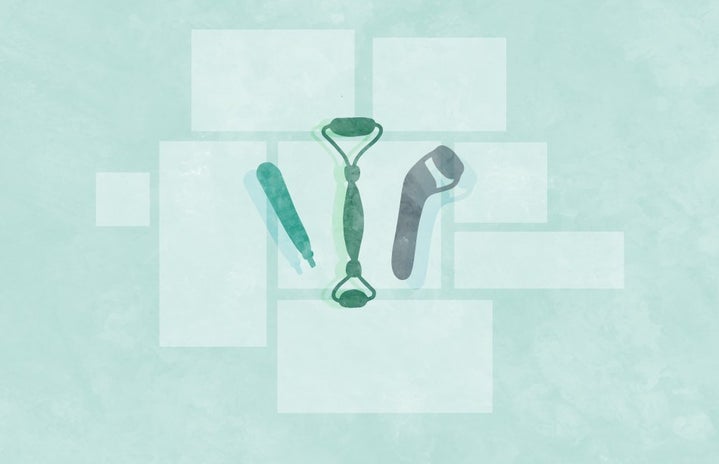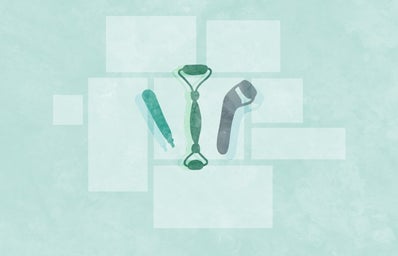You might have seen the countless Instagram posts, Tweets, and TikTok videos praising the gua sha (pronounced “gwahshah”) for its powers when it comes to keeping skin radiant and youthful. But the gua sha is much more than a social media trend, and its benefits are more than just skin-deep.
The history of the gua sha
Gua sha is a facial massage technique used in traditional East Asian medicine. The Chinese word is defined in two parts - “gua” meaning “scrape” and ‘sha’ meaning “sand” by some people, while others define it as “redness of skin.” Historical records on gua sha date all the way back to the Paleolithic Age where massaging parts of the body with hands or stones helped to reduce the side effects and symptoms of those who fell ill or entered a coma.
According to traditional Chinese medicine, qi or chi, which is energy that flows through the body, must be balanced and flow freely to ensure a person’s health and wellbeing. If your qi or chi becomes blocked, it may cause pain or tension in the muscles and joints, and the gua sha aims to move this blocked energy to relieve aches or stiffness.
How to use a gua sha at home
As with any kind of skincare practice, you have to do your due diligence to make sure it’s safe and healthy for you. Many recommend seeking out a reputable gua sha practitioner because a professional who has mastered the technique will produce the most visible results. However, it’s still possible to master gua sha techniques on your own!
Here are some tips:
1. Cleanse your skin and apply a reasonable amount of thick lubricant or oil all the way down to your neck (rosehip oil or jojoba oil work well).
2. Make sure your upper body and face is relaxed.
3. Hold the gua sha firmly in your hand in a 30–45 degree angle toward the area you’re about to treat.
4. Begin to move in one direction (do not change directions!) and scrape the first few strokes for some time before building pressure.
5. Maintain consistent pressure throughout your treatment. Don’t go too hard, or too soft. Too much pressure can cause bruising, so if it hurts — stop.
6. Apply long and continuous strokes between 15cm – 20 cm (approximately 6–7 inches).
7. Each stroke should be applied about 10 to 30 times before moving on to the next area.
8. Finish off with a warm towel (optional) and relax.
If needed, look up some how-to videos or visuals to get a clear grasp of the technique.
If you choose to practise this method at home: don’t gua sha over broken skin, raised blemishes, and moles; don’t use it if you are on blood thinners (do your research!); beware of cold sores or other viral infections on the nose, face or mouth; and, finally, the gua sha tool is hard and can therefore cause bruising to the face and neck if you apply too much pressure.

What can you expect from a gua sha treatment?
You have to remember that, like most skincare practices or products, a gua sha will not solve all your problems after just one use. You have to continue getting it done, or doing it on your own, on a regular basis for long-lasting results.
Here are just some of the benefits from gua sha (if used correctly, of course):
1. It promotes lymphatic drainage and breaks down tension in muscles and knots. Since we don’t move the muscles in our face all that much, the gua sha helps to move the lymph through the system and results in a more toned and sculpted appearance.
2. It can be used as a gentle, natural face-lift which results in less puffy eyes and sharper cheekbones, and may lessen the appearance of fine lines.
Pro tip: Pop it in the fridge/freezer and use it in the morning with your favourite creams and/or serums.
3. It increases blood circulation (reducing hyperpigmentation) while lifting and firming the skin. Just don’t be too aggressive in your approach and avoid any harsh motions, especially in sensitive areas.
4. Because it may decrease inflammation, gua sha is frequently used to treat sicknesses that cause chronic pains like arthritis and fibromyalgia, as well as those that trigger muscle and joint pains.
5. Gua sha relieves some of the side effects of migraine headaches, neck pain, perimenopause, hepatitis B, breast engorgement, and more.
You may notice slight bruising if you have applied too much pressure in some areas. Use a light hand when trying it out for the first time, and you should be good to go. Proceed with caution — your skin is precious!
It’s important to note that maintaining a healthy lifestyle, on top of using a gua sha, will play a huge role in maintaining skin health. Stay hydrated, limit inflammatory foods, and ensure proper detoxification through bowel movements, urination, and sweating.
Who should avoid using gua sha?
Gua sha is not suitable for everybody. So, if you…
- have had surgery in the last six weeks;
- have a medical condition that affects your skin or veins;
- have had botox or injectables within the past three to four weeks (you’ll need to wait at least four weeks from your most recent injection before beginning to use your gua sha);
- have an infection, tumor, or wound that is yet to be completely healed;
- bleed easily;
- have an implant (like a pacemaker or internal defibrillator);
- have deep vein thrombosis (DVT), which is a serious condition that occurs when a blood clot forms in a vein located deep inside your body;
- take medication to thin your blood and/or if you have a blood clotting disorder;
…you should stay away from using a gua sha.
As with anything, you should be doing your research to make sure it’s the right fit for you. Remember that the gua sha treatment is not supposed to be painful, but gua sha deliberately causes bruising (that heals within a few days), which may cause discomfort for some people.
Which one should I buy and where do I get it?
Before purchasing a gua sha tool, it’s important to consider the quality and material of the stone. If you purchase a higher quality one, not only will it last longer, but it will also provide a much more therapeutic effect. Remember that a quality gua sha made with authentic crystal or other natural material will often be of a slightly heavier weight than a knock-off or man-made one.
Also, some believe that different stones contain different properties, so here’s a run-down of the most common stones out there and what they do:
Green Jade: The traditional choice, it helps to protect from negative energy and promotes positivity. This one is best for contouring, lifting, and working out tight muscles.
White Jade: For reducing the appearance of puffiness and water retention.
Rose Quartz: Best for acne-prone skin, fine lines, and wrinkles.
Amethyst: For balancing inflamed complexions, soothing breakouts, and inspiring an intuitive mind.
Aventurine: Has anti-inflammatory properties, is best for problem skin prone to acne, eczema, or rosacea, and also attracts luck.
Sodalite: This one is great for releasing over-tight muscles and promoting a balanced complexion (it’s meant to calm an over-worked nervous system).
You can buy any of these stones online or in-store, but I recommend seeking out one from a traditional Chinese medicine practitioner (and support local Asian-owned businesses) instead of going straight to Amazon or a big-box retailer. You can explore options on Etsy, Facebook Marketplace, or online/in-person small shops, too.
The bottom line
Using a gua sha is a wonderful way to give yourself some healing and rejuvenation while treating specific skin concerns. It’s simple, straightforward, and many of its benefits are backed up by science (win-win-win!).
Follow up a facial massage with any products that help improve your skin’s condition. For healthy skin, use the right products, give yourself plenty of time to rest and relax, follow a good diet, and try to be active. Happy gua sha-ing!



